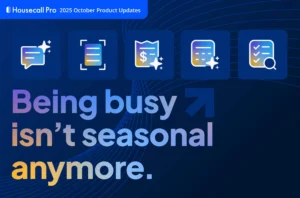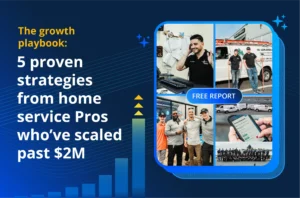Want to win more jobs with less effort?
Grow your business and send quick quotes with our home service software.

Want to see your potential revenue?
See what businesses like yours earn with Housecall Pro in 1 - 2 minutes.

A customer books you for a service. You discuss the terms, deliver the service, and wrap up the project. But how do you approach payment?
Would you send them an invoice requesting payment? Or would you wait until the funds land in your account and then issue a receipt? Here’s where most service business owners get confused when it comes to getting paid.
If you’ve ever wondered about the differences between an invoice and a receipt, you’re not alone. In this detailed invoice vs. receipt guide, you’ll discover what sets them apart and when to use each one. Plus, you’ll learn about free templates and Housecall Pro’s invoicing and payment software so you can quickly create an invoice and receipt for your service business.
Key Takeaways
- An invoice is a legal document you send to customers requesting payment for a service you delivered.
- An invoice is often mistaken for a bill. However, a bill is less detailed and is used to remind customers of how much they owe after receiving your services.
- A receipt provides proof that a customer has paid for a service. It’s issued as soon as a customer makes payment.
- The main invoice and receipt difference lies in the stage of the sales process when they are used. An invoice comes before payment, while a receipt comes after.
- The IRS requires businesses to maintain certain financial records, which include their taxable income and transaction details. So, a receipt and an invoice help you stay compliant.
- To simplify recordkeeping and receive payments without hassle, use a reliable tool like Housecall Pro’s payment processing software.
What Is an Invoice?
An invoice is a document you send to customers, itemizing the services you provided, along with how much they cost. It’s a payment request you send to customers after upholding your end of a commercial transaction.
As a seller, you decide what to include in your invoice. Whether you’re creating an invoice from scratch or using one provided by a payment processor like PayPal, these are the most important elements:
- Your business name and email
- Invoice number
- Customer’s name and email
- Invoice date
- Description of services provided
- Total amount due
- Payment terms
- Notes or comments
Is an Invoice the Same As a Bill?
Most people confuse invoices for bills. They also mix them up with other documents like estimates, proposals, and quotes. However, each serves a different purpose.
Businesses send invoices to request payment after delivering goods or services. On the other hand, bills are issued to remind customers of the amount they owe after receiving the products or services.
Another major difference between bills and invoices lies in their content. Invoices are typically more informative. They provide a detailed breakdown of the transaction, including the service description, terms, and amount due. Plus, they contain the contact information of both the seller and the buyer.
By contrast, a bill is less informative. It only mentions the amount due and the payment deadline. While they both request payments, an invoice is more detailed, and a bill is more straightforward.
What Is a Receipt?
A receipt is a document that provides proof of a transaction, confirming that a customer has paid for an item. Your receipt can be printed, handwritten, or digital—whatever is most convenient for you and your customers.
Here are the most important details your receipt should contain:
- Business name, logo, and contact information
- Brief description of goods or services sold
- Date of transaction
- Total amount paid
- Taxes or discounts, if applicable
You may also include a field for the customer’s signature or that of your business representative. This helps prove that the transaction was legitimate and can prevent any future conflicts or concerns about the purchase.
Can an Invoice be Used As a Receipt?
Many service business owners are wondering, “Is an invoice a receipt?” The answer is no. They are two separate documents used for different purposes. But what’s the difference between an invoice and a receipt?
Unlike receipts, invoices don’t prove that a customer has paid you. An invoice only verifies you delivered a service as agreed, while a receipt confirms that the customer paid you on a specific date.
Although invoices and receipts are documents associated with sales, they are issued at different stages within the cycle. You send an invoice to ask for payment after completing a service. Then, you issue a receipt as soon as the customer makes payment.
Why Are Invoices and Receipts Required for Service Businesses?
Now that you know what’s the difference between an invoice and a receipt, let’s see why these documents are important.
The Uses of Invoices
An invoice serves important purposes in service businesses. Here are some of its key uses:
- Payment Request: An invoice formally requests payment from the customer after you’ve delivered a service. It shows the exact amount due, leaving no room for underpayment. An invoice keeps both you and your customers on the same page regarding payment.
- Legal Protection: Although an invoice isn’t proof of a transaction, it gives you legal protection. It contains details of the services you delivered and the set price. This protects your business from fraudulent lawsuits and disputes over payment amount.
- Tax Filing: The IRS requires businesses to keep accurate records of their income. An invoice contains valuable information for tax purposes. These include taxable income, tax rates, and transaction details. An invoice serves as a reliable source of data during audits. It also helps you justify deductions and calculate total income.
- Payment Tracking: Invoices help you keep tabs on how much you’ve earned from a project. You can get your sales history and track payments that are due. An invoice makes it easy to handle your finances and make informed business decisions—like cutting off clients who always delay payments.
- Service Documentation: With an invoice, it becomes easier to document which projects you worked on, the number of hours spent, and the rates charged. If a client wants service details from any particular month last year, you can refer to your past invoices.
The Uses of Receipts
In a service business where you’re selling your time instead of products, what use is a receipt? Let’s explore this in detail.
- Evidence of Payment: A receipt verifies that a customer has paid for a particular service. It shows the specific day the payment was made and how much the service sold for.
- Tax Documentation: In the case of an audit, receipts are proof that what you claim as your income is true. They help in keeping your business well-documented and within legal frameworks.
- Recordkeeping: It’s important to have accurate records of all the services you offer. These include your rates, completed projects, and earnings. You can use the information to determine the financial health of your business.
- Business Intelligence: Over time, you can determine how much a returning customer generates in sales and which services they always purchase. This allows you to make informed decisions based on real business data.
- Accountability: There’s no question about whether or not a client has made payment. Also, there’s no dispute as to when payment was made because it’s all right there in writing. You can also follow up on clients who owe you money.
- Refund Processing: A receipt reveals how much money a client paid, which makes it easy to process refund requests.
Get In Touch: 858-842-5746
Let us earn your trust
On average, Pros increase monthly revenue generated through Housecall Pro by 50% after their first year.
See plan options and feature breakdown on our pricing page.
How to Create an Invoice
When it comes to creating an invoice, you have two options: a free template and field service invoicing software. Let’s explore how to write an invoice using each of them.
Free Invoice Template
An invoice template is a pre-filled document complete with sections for information such as your company name, customer details, and terms of payment. You’ll find free invoice templates online. These are perfect for startups, small businesses, and freelancers who want to cut costs.
Housecall Pro makes invoicing easy by providing free templates that suit various types of service businesses. Check out some of these templates:
- QuickBooks HVAC Invoice Template: Designed for HVAC technicians who need a professional way to bill for heating and cooling services.
- Small Business Invoice Template: Ideal for small businesses in any industry, whether you work face-to-face with customers or online
- Electrical Invoice Template: Meant for electricians who itemize labor, materials, and service calls
- Plumbing Invoice Template: For plumbers who want to detail how much they charge for different services
- Home Cleaning Invoice Template: Great for home cleaning professionals who want to send invoices after each appointment
- Handyman Invoice Template: Built for handymen who want to enhance their reputation when billing clients for repairs, installations, and odd jobs
How to Create an Invoice Using a Free Template
- Download a free invoice template in your desired format. You’ll find these versions: .doc, Excel file, or Google doc.
- Customize the invoice by adding your business name and contact information.
- Add the customer’s name and contact information.
- List the services you provided and your rates.
- Assign an invoice number to help you keep track of payments.
- Save and send the invoice.
Field Service Invoicing Software
Field service invoicing software is an online tool designed to help service businesses create, send, and track invoices. Unlike a template, field service invoicing software comes with a price tag. However, the cost is minimal when compared to the benefits you’ll enjoy.
Here’s a glimpse of what you can do with Housecall Pro’s field service invoicing software:
- Create invoices in one click.
- Manage multiple invoices from one central dashboard and get real-time updates.
- Automate follow-ups by email or text and get paid without any manual effort.
- Invoice large projects by milestone and based on your payment schedule.
- Allow instant payments via debit cards or bank transfers from anywhere in the world.
How to Create an Invoice Using Field Service Invoicing Software
Here’s how to create invoices using field service invoicing software like Housecall Pro’s:
- Sign up on your desired platform.
- Pre-fill your invoice with your business and customer details to save time and effort.
- Customize the invoice with your logo, business details, and other relevant details.
- Preview the invoice and make any changes if needed before sending it.
How to Create a Receipt
Creating a receipt for service businesses is similar to creating an invoice. You also have two options to choose from: a free receipt template and field service payment software.
Free Receipt Template
A receipt template is a quick and easy way to keep transaction records and simplify bookkeeping. Housecall Pro provides free receipt templates that allow you to include details such as a description of your services, how many hours you spent on the job, your rate, the total cost, payment methods, and any notes for the client.
Here’s a list of free receipt templates from Housecall Pro:
- Small Business Receipt Template: Perfect for any small business owner who wants to document sales professionally
- Plumbing Receipt Template: For plumbers who want to give customers professional proof of payment for plumbing jobs—whether it’s a leaky tap repair or a full bathroom installation
- Handyman Receipt Template: Made for handymen to document odd jobs, labor hours, material costs, and payment details on every project
- Electrical Receipt Template: Designed for electricians to log labor, materials, and service call fees while giving clients a clear payment record
- HVAC Receipt Template: Built for HVAC technicians to outline services provided, parts installed, and payments collected for heating and cooling jobs
- Pest Control Receipt Template: For pest control service technicians to record the services provided, chemicals used, and payments received
- Home Cleaning Receipt Template: Perfect for cleaning service companies to outline the details of cleaning, hours worked, and total costs for residential or commercial clients
Field Service Payment Software
Field service payment processing software is a digital tool that helps you collect payments, manage cash flow, and get paid faster. While receipt templates offer a free way to document payments, this software is not free. But it saves time, automates payment collection, and reduces the risk of manual errors.
Here are the top things you can do with Housecall Pro’s payment processing software:
- Accept security card payments at every customer touchpoint.
- Give customers the option to split large payments over time.
- Let customers book your services directly from your website.
- Scale your business with premium tools.
Automating Field Service Invoicing and Receipts with Housecall Pro
Receipt vs. invoice: which should you choose? As a service business owner, you don’t have to choose just one. Your business will benefit the most when you use receipts and invoices at different stages of the sales process.
Whether you’re creating these documents from scratch or using a template, you’ll spend time and effort on admin tasks. Housecall Pro simplifies invoicing and payment documentation by providing intuitive software that automates the process.
Sign up for a 14-day free trial and see how easy it is to scale your business.





